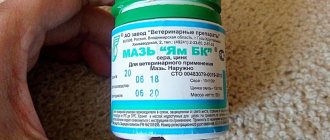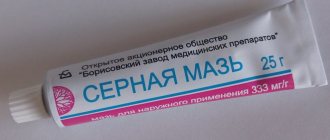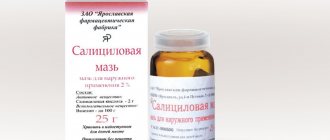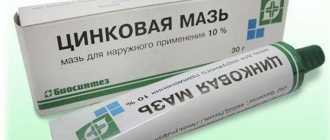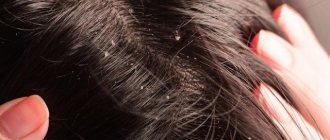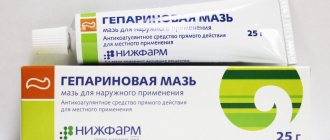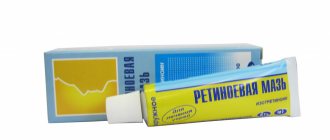Composition of the product
Salicylic acid
is a medicinal component of the ointment. Few people know that it was obtained from willow bark by chemist Rafael Piria. After all, the bark of the tree was and is used as an anti-inflammatory agent. In memory of the original source, the name of the acid contains the root salix, which is translated from Latin as willow.
Acid plays a major role not only in ointments, but also in alcohol solutions for external use, Lassar paste and anti-callus agents.
But in 100 g of salicylic acid ointment there are only 2 and 3 grams, which determines the percentage.
The rest is a Vaseline base. The result is a greasy white mass. It is sold in pharmacies in glass jars of 25, 50 and 100 g.
Salicylic ointment for pimples and acne
The advantage of using salicylic acid for oily and problem skin is that it removes excess secretion from the sebaceous glands and slows down its accumulation with prolonged use.
For this purpose, you need to select an ointment with a low percentage of the active substance and follow the instructions for use so as not to dry out the skin.
Salicylic acid will help make acne marks and acne less noticeable, and not just on the face. For the body, you should select a slightly higher concentration of ointment.
Therapeutic effect
Like all ointments, salicylic acid is an external agent. It is applied as:
- anti-inflammatory;
- antiseptic;
- keratolic (in high concentrations);
- local irritant medicine.
It is known that the product inhibits the secretion of sweat and sebum from the pores of the skin.
When is it appointed?
An inexpensive but effective remedy is used in the treatment of skin ailments. Instructions for use are:
- Increased sebum secretion
, caused by disturbances in the regulation of the functions of the sebaceous glands of the skin. The secretion of liquid sebum is noticeable on the face and scalp. This is why oily seborrhea, pimples and non-inflammatory acne appear. - Inflammatory skin diseases
with severe itching and rash, characteristic of eczema and dermatitis. - Chronic non-infectious skin lesions
: psoriasis and other types of lichen. - Physiological disorder of skin keratinization
, called dyskeratosis and ichthyosis. - Benign skin tumors
caused by viruses: warts and papillomas. - Calluses and corns
. - Traumatic skin lesions
: burns and wounds. - Infectious infections of the skin
with pathogenic fungi.
Some manage to find additional functions of salicylic ointment. What does acid help with in cosmetology? Believed to reduce wrinkles. Therefore, many women regularly use it as a component for making masks. But no studies have been conducted on the cosmetic effect. And due to its strong keratolytic (exfoliating) properties, it is used extremely carefully. There is a risk of serious complications.
What is salicylic ointment used for?
Salicylic ointment is an antiseptic and anti-inflammatory agent, has powerful keratolytic properties (removes dead cells from the surface of the skin).
It is used to cleanse wounds; in dermatology it is prescribed for the treatment of skin diseases that are accompanied by inflammation and excess fat.
Salicylic ointment is often prescribed in complex therapy to patients with psoriasis. It is suitable for external use only, not for internal use.
Instructions for use
To achieve improved well-being, follow the following rules when using the ointment:
- lubricate only the affected area;
- it is first cleaned of necrotic tissue and washed with antiseptics;
- squeeze out 0.2 g of ointment per 1 square centimeter;
- cover the top with a sterile napkin or sterile bandage;
- The dressing is changed every day, but is used for no more than a week.
The ointment is known to help against corns. Before lubricating them with salicylic ointment, the feet are steamed in warm water.
When fighting against calluses, pregnant women are advised to apply the ointment strictly to the callus itself and use no more than 5 ml of the product.
You can enhance the effect of salicylic ointment. For this purpose, applications, pieces of fabric or gauze soaked in ointment are used. After applying to the feet, socks are put on them. It is better to pamper yourself with a cosmetic procedure in the evening.
Advantages and disadvantages
Many readers are interested not only in the effectiveness of the drug in the treatment of corns, but also in some of its other benefits. Regarding Salicylic ointment, the advantages of its use are as follows:
- Availability of the product in Russian pharmacies and its dispensing without a prescription;
- Acceptable cost of the drug (about 0.30 USD);
- High efficiency of the drug;
- Possibility to use the product in any container (glass jar or tube).
Some disadvantages of Salicylic ointment include:
- The need for extreme caution when applying the product to the skin of the callus to avoid burning healthy tissue;
- Relatively low effectiveness of the drug in severely advanced cases;
- The risk of side effects such as allergies in a small percentage of patients;
Important: the use of Salicylic ointment during pregnancy is not recommended or only with the permission of the attending physician or obstetrician-gynecologist.
When is the drug contraindicated?
Knowing about the beneficial properties of the drug, you should always remember its contraindications. Why? The main component is very toxic in large doses. In the human body, it is destroyed, forming harmful compounds with hyaluronic acid.
Do not apply to warts with hair or in the genital area, face, or birthmarks.
For this reason, almost all pharmaceutical products containing the active ingredient are prohibited:
- pregnant women, as there is a risk of developing Reye's syndrome;
- nursing mothers;
- children;
- with renal dysfunction syndrome;
- with individual intolerance.
What to do if salicylic ointment gets on unprotected mucous membranes? It is recommended to wash off any remaining medication with water.
Conclusion about the drug
Salicylic ointment gives results for psoriasis : relieves irritation, itching, exfoliates. However, it must be used in combination with other medications.
For example, if the area of psoriasis is no more than 20%, you can exfoliate the scales and then apply ultraviolet 311 nm. With this course of treatment, if you follow the instructions, the remission will be long-lasting.
In addition, you can use folk remedies to treat psoriasis. They also help in complex treatment.
Side effects
Salicylic acid itself belongs to a group of powerful anti-inflammatory drugs that are known for their side effects. But in the ointment its concentration is quite low, so the number of side effects is minimized.
When used, the following are possible:
- scratching;
- redness;
- the appearance of a burning sensation;
- rash and other signs of an allergic reaction.
They arise at the site of application of the drug.
Therefore, before use, the product is tested on the wrists or elbows. If after a few minutes signs of allergy do not appear, then you can use it freely. When treating psoriasis and weeping lesions, you need to take into account that psoriatic plaques and weeping wounds absorb a larger volume of medicine.
[media=
https://youtu.be/lUz2RX4ElAk
]
Application of ointment
According to the instructions, the drug is applied only to clean and dry skin. The product is applied to the affected area up to 6 times a day.
The duration of treatment can be up to 1 month. The amount of product depends on the area of damage.
If wounds and burns are being treated, a bandage should be applied. It is also good to use the ointment as a preventive measure for diaper rash.
Always have instructions at hand.
It is better not to use the product without permission. First you need to go to the doctor. Only after consultation with a specialist can treatment begin.
Cost of ointment and its analogues
Salicylic ointment is freely sold in pharmacies, like its analogues. Moreover, it is very cheap. If there is no product produced by pharmaceutical companies, pharmacies can prepare it themselves.
In many preparations, it becomes a therapeutic “partner” and is combined with other components, which makes the price much higher. More detailed information on the cost of products containing the active ingredient is in the table
.
| Name | Manufacturer country | Release form, components | Volume, ml | Concentration, % | Cost, rub. |
| Salicylic acid | Russia, various | Alcohol solution | 40 | 2 | 6 — 13 |
| Salicylic acid | Russia, various | Alcohol solution | 40 | 1 | 15 |
| Salicylic ointment | Russia, various | Ointment | 25 | 2 | 27 |
| Combination drugs | |||||
| Sulfur-salicylic ointment | Russia, various | Ointment with sulfur and salicylic acid | 25 | 2 | 13 |
| Salicylic-zinc paste | Russia, various | Paste with zinc oxide and salicylic acid | 25 | 15 — 36 | |
| Viprosal B | Estonia, Tallinn Pharmacy. factory | Ointment with camphor, salicylic acid and pine needle oil | 30 50 | 252 358 | |
| Teymurova paste | Russia, Green Dubrava | Paste with salicylic and boric acids, lead acetate, zinc acetate, talc, formaldehyde | 30 50 | 43 60 | |
The substances with which the active substance is combined expand the list of healing possibilities. Sulfur-salicylic acid is used in the treatment of fungal diseases. Containing zinc, it dries out inflamed skin, so it is used in the treatment of weeping sores.
Action and properties of the ointment
Salicylic acid (in other words, phenolic acid) was discovered in willow bark several centuries ago. It was she who became the predecessor of aspirin (acetylsalicylic acid), which is still actively used in medicine to treat a wide range of diseases.
By using salicylic ointment, you can speed up the healing of wounds, boils, pimples, blackheads, and soften growths and calluses on the skin.
Due to the pronounced keratolytic effect of the ointment, skin regeneration increases. Its antiseptic effect is widely used in the treatment of wounds and skin diseases accompanied by a violation of the integrity of the skin.


